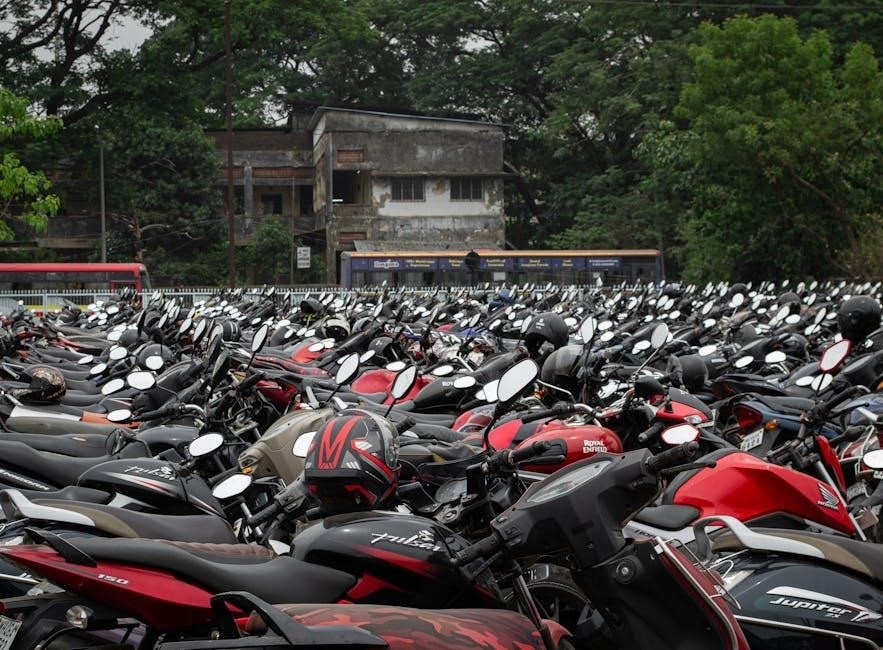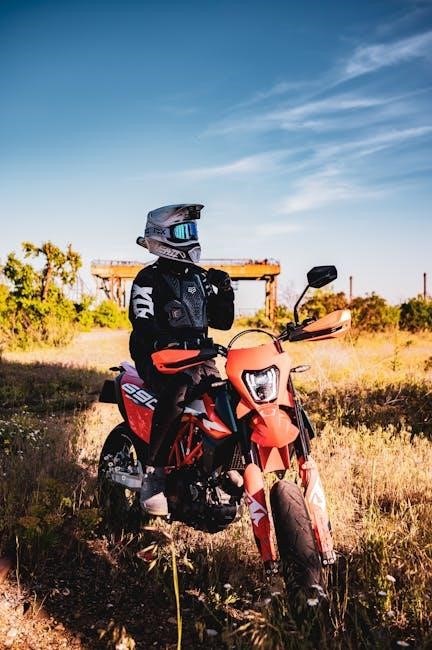The Navy emphasizes motorcycle safety and standardized training to reduce accidents and enhance rider skills. The program includes two levels of instruction, starting with the 16-hour Basic Rider Course (BRC), certified by the Motorcycle Safety Foundation (MSF), designed to teach essential riding techniques and safety protocols for all naval personnel.
1.1 Overview of Motorcycle Safety in the Navy
Motorcycle safety is a top priority in the Navy, with a focus on reducing accidents and enhancing rider skills. The Navy’s motorcycle training program is structured into two levels, ensuring all personnel receive comprehensive instruction. Level I, the Basic Rider Course (BRC), is a 16-hour MSF-certified program that covers essential riding techniques and safety protocols. This training is designed to equip riders with the knowledge and skills needed to operate motorcycles safely, both on and off naval bases. By emphasizing proper training and adherence to safety guidelines, the Navy aims to minimize risks and protect its personnel.
1.2 Importance of Proper Training for Naval Personnel
Proper motorcycle training is crucial for naval personnel to ensure safe operations and mission readiness. Accidents can lead to injuries, financial loss, and decreased operational efficiency. The Navy’s structured training programs, such as the Basic Rider Course (BRC), are designed to minimize these risks by teaching essential skills and safety protocols. By mastering these techniques, personnel reduce their likelihood of being involved in accidents, maintaining their ability to perform duties effectively. This training also fosters a culture of safety within the Navy, protecting both individuals and the organization as a whole. Effective training is vital for preserving human resources and operational capabilities.
Levels of Motorcycle Training in the Navy
The Navy offers two structured levels of motorcycle training. Level I is the Basic Rider Course (BRC), a 16-hour MSF-certified program for beginners. Level II provides advanced techniques for experienced riders, focusing on refining skills and safety practices.
2.1 Level I: Basic Rider Course (BRC)
The Basic Rider Course (BRC) is a 16-hour, MSF-certified program designed for beginners. It combines classroom instruction with hands-on training, teaching riders fundamental motorcycle control and safety practices. Topics include starting and stopping, shifting gears, turning, and braking techniques. Riders also learn basic motorcycle mechanics and safety protocols. The course emphasizes hazard awareness and risk management, preparing participants for real-world riding scenarios. Completion of the BRC is mandatory for all naval personnel seeking to operate motorcycles, ensuring a strong foundation in safe and skilled riding practices.
2.2 Level II: Intermediate Rider Course
The Intermediate Rider Course is designed for experienced riders seeking to refine their skills. This advanced training focuses on improving cornering techniques, braking strategies, and overall vehicle control. Participants learn to navigate complex traffic scenarios and enhance their ability to anticipate hazards. The course also covers group riding safety, emphasizing communication and formation protocols. Building on the foundational skills from Level I, this program ensures riders are better equipped to handle challenging conditions. It is MSF-certified and tailored to meet the unique demands of naval personnel, ensuring a higher level of proficiency and safety on the road.
Motorcycle Safety Protocols
Motorcycle safety protocols are critical for naval personnel, emphasizing the use of Personal Protective Equipment (PPE) and pre-ride inspections. These practices ensure riders adhere to safety standards, reducing risks.
3.1 Personal Protective Equipment (PPE) Requirements
Personal Protective Equipment (PPE) is essential for naval motorcycle riders to minimize injury risks. The Navy mandates the use of approved helmets, gloves, durable jackets, pants, and sturdy boots. Helmets must meet DOT or Snell certification standards to ensure optimal protection. Gloves should be made of abrasion-resistant materials to protect hands during falls. Jackets and pants are typically constructed from leather or reinforced synthetic fabrics. Boots must cover the ankles for added support. Proper PPE compliance is strictly enforced to enhance safety and reduce potential harm in the event of an accident. Adherence to these standards is crucial for all naval personnel operating motorcycles.
3.2 Pre-Ride Inspection and Safety Checks
Conducting a thorough pre-ride inspection is critical to ensure motorcycle safety and reliability. Naval personnel are required to check tire pressure, tread depth, and look for any signs of damage. Brakes, both front and rear, must be tested for proper function and fluid levels. Additionally, riders should inspect the motorcycle’s lights, signals, and mirrors to ensure they are operational. The chain or belt should be checked for wear and tension, and all fluids, such as oil and coolant, must be at appropriate levels; A pre-ride inspection helps identify potential issues before they lead to accidents, ensuring a safer ride.
Road Safety and Traffic Laws
Naval personnel must adhere to strict road safety protocols and traffic laws, both on and off base, ensuring compliance with civilian regulations while maintaining high safety standards.
4.1 Understanding Naval Base Traffic Regulations
Naval base traffic regulations are designed to ensure safety and order for all personnel. Riders must adhere to specific speed limits, right-of-way rules, and parking guidelines. All motorcycles must be registered and insured, with proof of insurance carried at all times. Personnel are required to wear approved Personal Protective Equipment (PPE) while operating motorcycles on base. Additionally, motorcycles may only be operated in designated areas, and riders must follow all traffic signs and signals. Violations of these regulations can result in disciplinary action, emphasizing the importance of strict compliance to maintain a safe and orderly environment for all base personnel.
4.2 Adhering to Civilian Traffic Laws While on Duty
Naval personnel must comply with civilian traffic laws when operating motorcycles on public roads, even while on duty. This includes adhering to speed limits, right-of-way rules, and stop signs. Riders must ensure their motorcycles are registered and insured according to state laws. Proper use of Personal Protective Equipment (PPE) is also mandated by both military and civilian regulations. Failure to follow traffic laws can result in legal penalties and disciplinary action under the Uniform Code of Military Justice (UCMJ). Adhering to these laws ensures safety, upholds the Navy’s reputation, and avoids potential legal consequences.

Advanced Riding Techniques
Advanced riding techniques involve refining balance, control, and precision at higher speeds, emphasizing safety through structured MSF training and continuous practice of foundational skills.
5.1 Cornering and Braking Strategies
Cornering and braking are critical skills for naval motorcyclists, requiring precise control and judgment. Riders learn to approach turns by leaning at appropriate angles, using countersteering techniques, and adjusting speed before entering curves. Braking strategies emphasize gradual deceleration, balancing front and rear brake pressure to avoid skidding. Proper body positioning and weight distribution are stressed to maintain stability. These techniques are practiced in controlled environments to build muscle memory and confidence. Emphasis is placed on anticipating hazards and adjusting speed to navigate safely, ensuring riders can handle various road conditions effectively while adhering to safety protocols.
5.2 Group Riding Safety and Formation
Group riding safety is essential for naval motorcyclists to maintain cohesion and reduce risks. Riders are trained to follow a staggered formation, allowing space for reaction time and maneuverability. Hand signals and clear communication are emphasized to ensure all members are aware of changes in speed or direction. The lead rider sets the pace and alerts others to potential hazards, while trailing riders must stay alert and maintain safe distances. This formation minimizes accidents and enhances visibility, ensuring the group moves as a unified, safe unit. Proper formation and communication are critical for mission success and rider safety.

Maintenance and Care of Naval Motorcycles
Regular inspections, lubrication, and tire checks are crucial for optimal performance and safety. Naval personnel are trained to identify and address mechanical issues promptly to prevent malfunctions.
6.1 Routine Maintenance Checks
Routine maintenance is essential for ensuring naval motorcycles operate safely and efficiently. Riders are trained to perform regular inspections, including checking tire pressure, brake systems, fluid levels, and chain tension. These checks help identify potential issues before they escalate. Documentation of maintenance activities is required to track the motorcycle’s condition over time. Proper lubrication of moving parts and timely replacement of worn components are also emphasized. Regular maintenance not only extends the lifespan of the vehicle but also ensures reliability during critical operations. Neglecting these checks can lead to mechanical failures, posing safety risks to riders and others on the road.
6.2 Reporting and Addressing Mechanical Issues
Naval personnel are required to promptly report any mechanical issues with their motorcycles to ensure safety and operational readiness. Riders must submit detailed reports outlining the nature of the problem, its impact on vehicle performance, and any safety concerns. Maintenance crews then assess and prioritize repairs based on severity. Issues are addressed using standardized procedures, and all repairs must be documented for record-keeping. Timely reporting and resolution of mechanical problems are critical to preventing accidents and maintaining fleet reliability. This process ensures that all motorcycles remain in optimal condition for both on-base and off-base operations, safeguarding riders and mission effectiveness.

Emergency Procedures and Accident Response
The Navy has standardized protocols for emergency situations, including immediate actions post-accident, securing the scene, and providing first aid. Riders must notify authorities promptly and follow established procedures to ensure safety and proper documentation.
7.1 What to Do in Case of an Accident
In the event of a motorcycle accident, naval personnel must prioritize safety and follow established protocols. First, assess the situation to ensure no further danger exists. Provide immediate assistance to injured parties, administering first aid if trained. Notify local authorities and naval command promptly, ensuring a thorough incident report is filed. Secure the accident scene to prevent additional hazards and document all details, including photos and witness statements. Proper documentation is critical for investigations and ensuring accountability. Adhering to these steps helps maintain order and supports a swift recovery process.
7.2 First Aid and Injury Prevention
Naval motorcycle instruction emphasizes immediate first aid and injury prevention to minimize harm after an accident. Riders should assess injuries, control bleeding with clean dressings, and stabilize limbs if fractures are suspected. Concussions or head trauma require immediate medical attention. Preventive measures include wearing Personal Protective Equipment (PPE) like helmets and padded gear to reduce injury severity. Regular training reinforces these practices, ensuring riders can respond effectively in emergencies. Proper first aid knowledge is crucial for safeguarding themselves and others until professional medical help arrives. These protocols are integral to the Navy’s commitment to rider safety and accident mitigation.

Continuous Learning and Skill Improvement
The Navy encourages continuous learning through refresher courses and recertification programs. Riders must stay updated on new safety guidelines and best practices to enhance their skills and safety on the road.
8.1 Refresher Courses and Recertification
Refresher courses are essential for maintaining and improving motorcycle skills. These courses, offered periodically, focus on reinforcing safe riding practices, updating riders on new techniques, and ensuring compliance with current safety standards. Recertification is required to confirm that riders meet the Navy’s stringent safety and proficiency criteria. By participating in these programs, personnel can address any skill gaps and stay informed about the latest developments in motorcycle safety. Regular recertification ensures that all riders are up-to-date and capable of operating their motorcycles safely and effectively, both on and off base.
8.2 Staying Updated on New Safety Guidelines
Staying informed about the latest safety guidelines is critical for naval motorcycle operators. The Navy regularly updates its safety protocols to reflect advancements in training, equipment, and accident prevention. Riders are encouraged to review official Navy publications, attend safety briefings, and participate in workshops. Additionally, the Motorcycle Safety Foundation (MSF) provides updated resources and training materials. By staying updated, personnel can adopt best practices, reduce risks, and ensure compliance with evolving safety standards. Regular updates also help address emerging challenges and improve overall riding safety, both on and off military bases.

